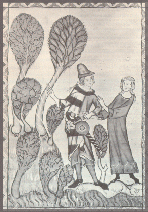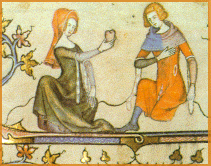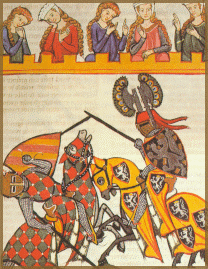
The singer is performing a poem by the 12th Century troubadour Bernart de Ventadorn (right). Troubadours were poet-singers from Provence in the south of France. They were famous for their lyrics about love.

A lover tries to persuade his lady to go with him
In these poems the woman the poet is in love with is described as all-powerful. He is her servant, her slave, her prisoner. He says she is his 'lord', his 'master', his 'jailor'. The lover sighs and weeps, he does not eat or sleep. He trembles when the lady is near. He grows pale and ill with love, and only she can make him better. Often in the troubadour poems, the lady rejects the lover, or does not even notice he exists, but he goes on loving her anyway.

A lady takes her lover prisoner by binding him with gold threads of love
Some of these ideas came from a famous book by the Latin poet Ovid called The Art of Love, written hundreds of years before. Yet 'courtly love' also came to France from Spain, where many Arabic poets lived in the 10th and 11th Centuries. The Arabs had different attitudes towards women and their poems were full of gardens and love and pleasure, while the Christian Europeans still preferred tales of warrior-heroes, battles and monsters.
However, this new way of thinking and speaking about love soon became very fashionable in the courts of France, and later England and Germany. Noble ladies in particular liked to hear about love. Noblewomen like Eleanor of Aquitaine, Queen first of France and then of England (as wife of Henry II), and her daughter Countess Marie of Champagne encouraged poets to write about the problems and pleasures of love. Chrétien de Troyes wrote at least one of his stories for Marie, whose court was at Troyes. These famous ladies held Courts of Love where lovers presented their cases and women passed judgement, deciding whether the lover was worthy of his lady, or whether she had treated him fairly.

A lady gives her heart to a lover
Writers about courtly love did not think this kind of love was very likely to exist between a husband and wife. In noble families in the Middle Ages, marriages were almost always arranged by the parents. The bride and groom-to-be might be only babies at the time. The wedding could take place as soon as the children were seven years old. So perhaps it is not surprising that people did not expect to be in love with their husband or wife. Yet although courtly lovers were seldom married to one another, often one or both of them might be married to other people. Keeping it a secret so the husband or wife didn't find out was thought to be one of the pleasures of love.

Two knights fight in front of ladies
Courtly love soon became part of the tales of King Arthur and his knights. It was already part of the idea of chivalry (what it meant to be a perfect knight) that a knight should defend women and keep them from harm. According to the troubadours, a man in love must do everything he can to make himself worthy of his lady. So now there was a new feeling that knightly deeds could be performed in order to gain a lady's love. This is why a knight fighting in a tournament often wore a 'favour' (such as a scarf or flower) from his lady, to show that everything he did on the field of battle was to win her love and admiration.